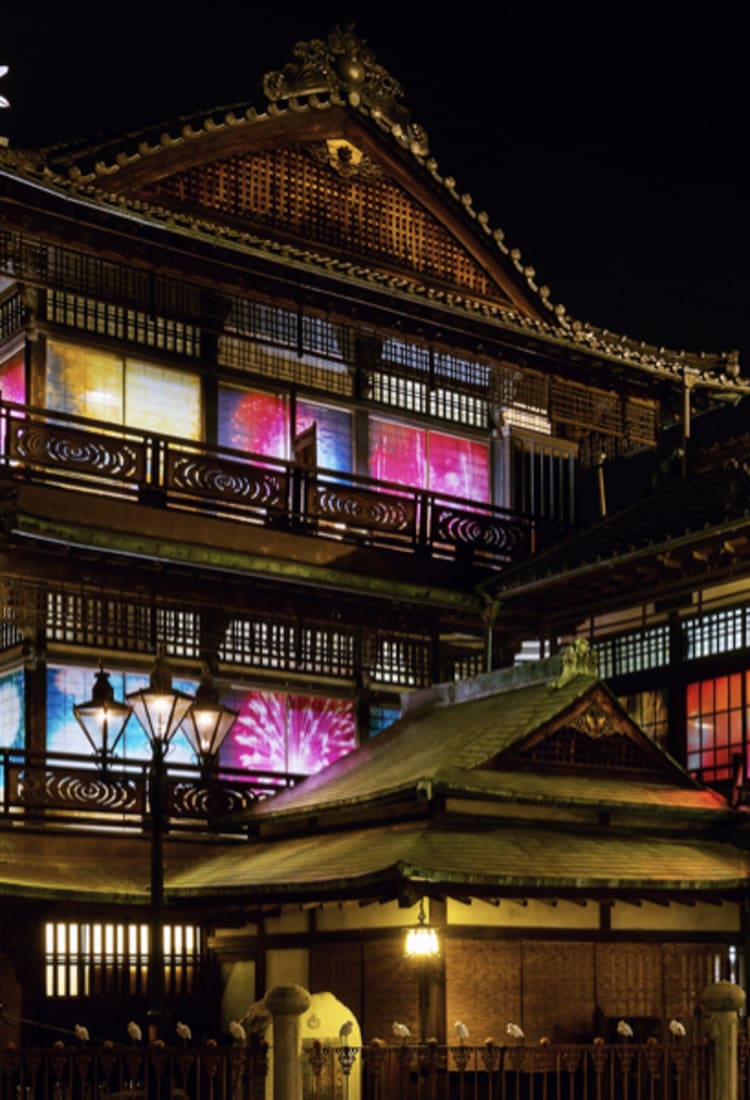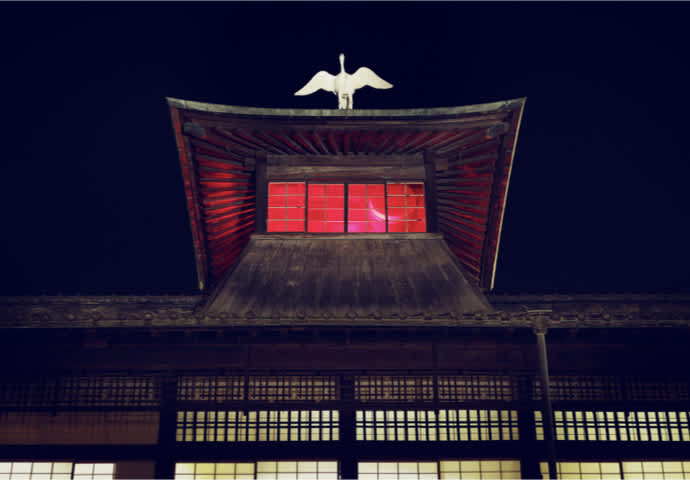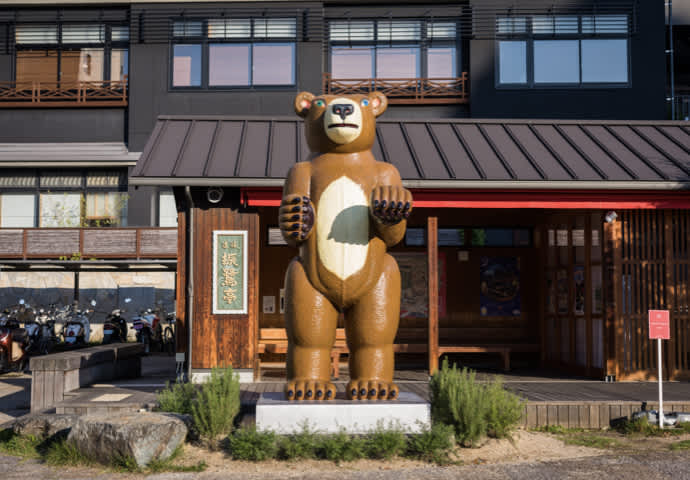
Dogo Onsen, one of the oldest hot spring areas in Japan, gets covered in cutting-edge art installations
Dogo Onsen, one of the oldest hot spring areas in Japan, gets covered in cutting-edge art installations
The enduring symbol of Dogo Onsen dressed up in art

The Shinrokaku tower atop the Dogo Onsen Honkan glows with red light as night falls. Perched on the tower is a white heron, an egret that legend says led to the discovery of the hot springs here.
With a history stretching back three thousand years, Dogo Onsen (English available) is said to be one of Japan’s oldest hot springs. It is also the site of the Dogo Onsenart art festival, which are being held through the end of February 2019. The nostalgic atmosphere of the hot spring village is mixed with the cutting-edge art, bringing fresh discoveries and surprises to visitors.
The Dogo Onsen Honkan is a public bathhouse that has come to stand as a symbol of the entire hot spring village. It is located roughly at the center of an area that stretches out some 200 meters in every direction and contains nearly every art piece and scenic highlight of the town. Being able to wander around and look at everything is one of the area’s biggest charms.
Built over 120 years ago, the Honkan is a building rich in historical value, yet with fully operational bathing facilities as well. In 1994, it was the first public bathhouse to become a Nationally Designated Cultural Property. It is a dignified structure that is itself a piece of art, especially with the red glow emanating from the Western-style giyaman glass fitted in the top windows of its Shinrokaku tower.

Guests are allowed to enter the installation, where they are greeted with a scene as enchanting as the core of a camellia flower.
The Dogo hot spring village is also home to public bathhouses, such as a concrete public bathhouse called Tsubaki-no-Yu, and one called Asuka-no-Yu, which includes elements of ancient building styles from the Asuka period (592–710). While you’re going around checking out these landmarks, you’ll also encounter public art scattered throughout the village.
At the entrance to Tsubaki-no-Yu is a sculpture called Echoes Gekko, made using nebuta festival float techniques. In the central courtyard at Asuka-no-Yu is a three-dimensional work entitled Tsubaki (Camellia), inspired by the city flower of Matsuyama. (Both works are by Shinji Ohmaki.)
There are tours available as part of the Hotel Project, which also allows guests to stay in rooms transformed by artists. These and other limited-time art events continue to draw in art-loving visitors day after day.
Surround yourself in art–even in your room! Enjoy a variety of art pieces.

Yukata by artist Makoto Kagoshima, printed with designs inspired by Dogo Onsen and the Ginza district of Tokyo.
Be sure to check out the four suggested tours presented on the official Dogo Onsenart 2018 website. They range from a mini tour that focuses primarily on the public art pieces to full half-day adventures.
If you’re going for the art, you should definitely start out by renting a yukata garment printed with an original design just for the Dogo Onsenart 2018 festival. They’re available for overnight guests staying at select ryokan and hotels during the event, but day trippers can also rent them at a longstanding ryokan called Funaya (English available) .
The original yukata are designed by ceramic and textile artist Makoto Kagoshima, and are one of the artistic pieces of the event. Wear your yukata as you enjoy meals and lounge around your hotel, and keep them on as you head out to walk the village streets. In winter, keep out the chill with thermal undergarments and a haori jacket.
Knowing something about the history of Dogo Onsen will help you appreciate the art installations even more. The photographic piece Sagi no Ongaeshi by Masashi Asada that is on display in the Dogo Onsen Honkan, for example, brings the legendary beginnings of Dogo Onsen to life. Legend has it that a wounded egret came to Dogo Onsen to soak in the healing hot springs some 3,000 years ago. Amazed by this, the local people followed suit, and a hot spring village was born. Asada’s pieces tell the story.

Asada also appears somewhere in each photo, adding a series of eight self-portraits to the mix.
Throughout its history, Dogo Onsen has always been a favorite destination for writers and cultural figures. The great writer Soseki Natsume once taught school in Matsuyama, and the city is the setting for his classic work Botchan. Botchan has been translated into numerous languages in the 111 years since it was first published, and is still being adapted and reprinted today.
Why not grab a copy of Botchan in English and compare it to the Japanese original? You can if you visit the Heyabon Botchan installation by Shin Sobue, which is part of the Hotel Project at the Dogokan (English available) .

In this piece, the entire room is transformed into a three-dimensional book of Soseki Natsume’s famous novel. The installation is open from 11 AM to 2 PM (last entry) for 20-minute tours. The cost is ¥1,500 (¥1,000 for children 12 and under) and comes with a gift souvenir.
If you want to go back to the roots of the Dogo hot springs, head out to Dogo Park. It’s the site of a former castle that once stood at the center of Dogo. Japan’s oldest existing yugama boiler*2 is here, indicating close ties to the local hot spring culture.
Two art pieces by Atsuhiko Misawa pay homage to the zoo that was once located in Dogo Park: Animal 2017-01-B2 (Bear) and Animal House. Both can be seen at the Shinrotei, a rest area located behind the Dogo Onsen Honkan. Experience the interesting connections between the art pieces and the history of the town.
*2 Yugama boilers were kettles used to boil water. The word can also refer to a volcanic lake.

A giant bronze bear statue stands at the Shinrotei facing the Dogo Onsen Honkan, creating the perfect photo opportunity.
Discover more delights in the poetic castle town of Matsuyama

The keep of Matsuyama castle was reconstructed at the beginning of the 19th century. Since then it has been spared from fire and destruction, making it a valuable cultural treasure.
See everything Matsuyama has to offer besides its hot springs when you head to the town before or after enjoying the artwork at the Dogo Onsenart event. Start your journey at JR Matsuyama Station. There are lots of convenient ways to get around the city once you’re there. There’s a loop line that runs around Matsuyama Castle, as well as the Botchan Ressha, a streetcar inspired by the train that appears in Soseki Natsume’s Botchan.

The Botchan Ressha streetcar is a replica of an old steam locomotive. It links Dogo Onsen Station with Okaido, for example, which is the closest stop to the boarding point for the ropeway headed to Matsuyama Castle.
Matsuyama Castle took 25 years to build back in the early years of the 17th century. Perched on the top of Mt. Katsuyama at an elevation of 132 meters, it is best accessed by a ropeway or ski lift that runs from the Okaido streetcar stop (a five-minute walk away) to the summit. There are also mini trekking courses and other walking trails that follow the natural mountain terrain. The keep*3 offers sweeping views of Matsuyama city, making it apparent that this was once a castle town.
*3 The most symbolic structure of a Japanese castle
Matsuyama is also known as a “city of poetry”, thanks to the deep-rooted haiku culture that exits here. A website called Haiku Capital Matsuyama (English available) explains the city’s ties to Shiki Masaoka (the founder of modern Haiku), his student Kyoshi Takahama, and numerous other great poets. The haiku slabs are located around town and haiku-related events are held throughout the year. There are “haiku mailboxes” around the city as well, allowing anyone to compose and post a poem at any time.

There are over 90 haiku mailboxes scattered throughout Matsuyama. The city also holds four poetry contests a year.
Matsuyama is a city of hot springs, a castle town, a haiku haven, and more… And who knows? As you immerse yourself in the many faces of the city, the sights and feelings that arise as you stroll around may even inspire you to compose your own haiku!
For more information
Matsuyama Convention and Visitors Bureau
Ehime tourist information site




















































